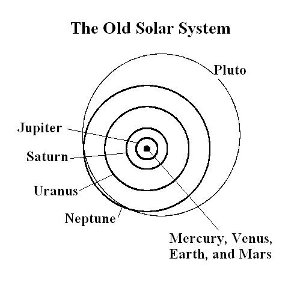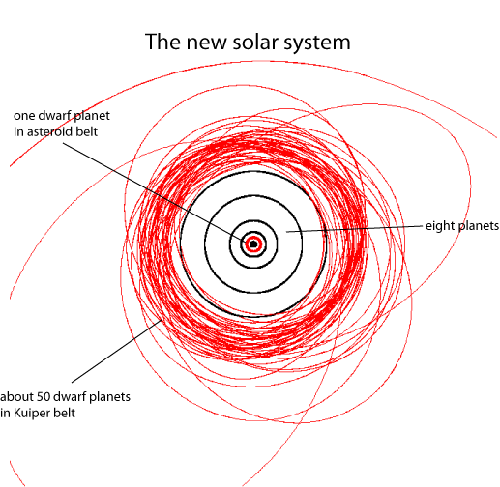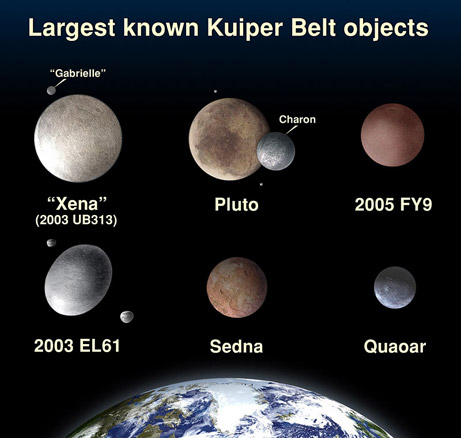One of the surprises of the Aosta conference was Joel Poncy’s presentation on a fast orbiter mission to Haumea. Poncy (Thales Alenia Space, France) and colleagues have been developing ideas for the extraordinarily difficult challenge of not just sending a probe to the outer system, but slowing it down for orbital capture. It’s one thing to do this, say, for Neptune, where a thick atmosphere can be used for aerobraking, but it’s quite another to contemplate doing the same for an airless trans-Neptunian object (TNO) like Haumea.

Nonetheless, there are solid reasons for thinking about such a mission. The first is purely scientific. As Poncy did, I’ll use outer planet specialist Mike Brown’s illustrations of what has happened to our Solar System in the last few decades. The first illustration shows the Solar System most of us grew up with, a system with nine planets that were more or less clearly defined, with what was assumed to be a certain amount of debris and cometary material further out.
Now, of course, we see a new Solar System. Depending on how we define planets, we can declare that we have numerous such objects in the outer system — call them ‘dwarf planets’ — along with, much further out, the enormous, spherical system known as the Oort Cloud. Think about this: The number of objects with a diameter beyond 500 kilometers has doubled in just ten years from thirty-five to more than seventy as we’ve continued our investigation of trans-Neptunian objects. It is fully assumed that within another decade or two, we’ll know of hundreds more of these objects.
Let me quote Poncy on this:
If we now recap all sizable Solar System planetary objects larger than 500 km, we get 19 objects closer than the orbit of Uranus, orbit-able after a decade or so of cruise with current technologies. Uranus itself can be flown by but not orbited for a decent travel time. We have already more than 40 objects at Uranus and beyond and this number will grow considerably by 2020. This is even starting to change the appellation ‘Outer System,’ which was previously used to name the part beyond the frost line at 4 AU, and is now sometimes used to designate the part beyond 30 AU.

Image: A new Solar System emerges. Credit: Mike Brown/Caltech.
Consider, too, that we once thought of the the Solar System as being enclosed in a well defined heliosphere that separated it from true interstellar space. Now we have objects like Sedna, with an aphelion (942 AU) that is well beyond the heliosphere. In moving to its perihelion at 76 AU, Sedna moves from interstellar space into the heliosphere and then gradually works its way back out again. The new Solar System is packed with objects that defy all the definitions we once brought to the term.
As for Haumea itself (once known as 2003EL61), we’re looking at a most unusual little world. You can study its light-curve to determine that it’s spinning quickly, about once every 3.9 hours. More unusually, rather than being spherical, it appears to be a flattened ellipsoid with its largest axis in the range of 2000 kilometers. One of the thirty largest objects in the Solar System, it is orbited by two moons, the largest — Hi’iaka — being rather large in itself, with a diameter estimated to be 300 kilometers.

Image: Relative sizes of the larger outer system objects. Note the ellipsoidal shape of 2003EL61, now known as Haumea. Credit: NASA/ESA/A. Feild (STSci).
The current thinking is that Haumea is the result of a major collision, one that produced the entire system of TNO and two moons. Adding to the interest is that Haumea is quite reflective, its surface covered with crystalline water ice. This could be interpreted as evidence for cryovolcanism (think Triton), and brings home the usefulness of an orbiter. After all, a flyby mission is not going to be able to track transient phenomena over time. Moreover, the orbital dynamics of the system, including the interactions of its moons and the tidal effects of Haumea itself, are complex and will need long study to understand.
Can we get to this unusual object, which is now close to aphelion at 51 AU from the Sun? It’s certainly within range of our probes, but orbiting it would not be easy. We’ll look at the why and how of such a mission tomorrow.


Great use of the soon to be space tested VASIMR propulsion system. VASIMR unlike ion propulsion has a higher thrust, lower (but still high a few thousand seconds) ISP option useful for orbit insertion at the destination. As always the problem is power source but I find it amazing that a society that has multiple nuclear reactors sailing in and out of nearby populous downtown Portsmouth NH won’t fly a nuke in space.
http://www.adastrarocket.com/VASIMR.html
http://en.wikipedia.org/wiki/Variable_Specific_Impulse_Magnetoplasma_Rocket
Now that is an exceptionally interesting target… the emphasis on Mars missions gets a bit wearisome after a while. There are other places to go in our solar system. Not sure if it would be a more worthwhile mission than say a Neptune+Triton mission (which I am pretty much resigned to not seeing the results of in my lifetime even if one gets launched), but would provide information about a very weird object.
If O’neill style space colonization happens, it is likely that TNO’s will be the likely locations and resource bases for such space colonization. Freeman Dyson talks about this in some of his books.
andy,respectfully if i may say so…it is just that mars is the next logical stepping off point,at least to my mind,after the much ballyhooed return to the moon.after that yes sir! fling open the gates to the solar system! your neptune – triton mission concept is a good one too. i also want to have a look at the kuiper belt and oort cloud.however just for the moment those missions seem just a slight bit ambitious.more, a better propulsion is what we need.marc millis as head of nasa’s breakthrough propulsion physics project knew/KNOWS all about that! respectfully,your friend george
Seeing as comets and KBOs are considered pristine remnants of the early
Sol system, plus their future value as fuel sources (water ice) for spaceships
and colonies (including drinking water?), we should be learning as much as
we can about them as part of our initial setup of our interplanetary
infrastructure.
What an interesting article. I just wonder when Sedna will be at its perihelion (76 AU) from Sol. This interests me because its aphelion is in the solar gravitational focal region. It would be very interesting to land a space probe on Sedna’s surface and observe the environment of the outer space along its path.
Isnt there another KBO just waiting for a repeat visit, and an extended tour Cassini style thanks to aerobraking in its parent world’s atmosphere? Its name is Triton, and there would be plenty of bonus science to be had too! :)
P
Hi All
P, it’s just possible to drop a lander on to Triton to deccelerate via ballute in the thin, but deep Tritonian atmosphere. It would launch off the main Neptune probe bus before the bus aerobrakes, then hit Triton’s atmosphere for a quite hard decceleration at ~ 12 gees, before touching down on a bit of rocket thrust. Might need to switch from hot jets to compressed nitrogen before contact or maybe an airbag cushion.
Other KBOs probably have decent atmospheres too, if not too cold. Pluto is a prime example and there’s still a chance we’ll find a closer v
Aren’t Xena and Gabrielle offically known by other names? I must admit that I love the idea of a KBO and it’s moon called Xena and Gabrielle!
Getting back to the probe, Propellent is going to be the major issue, there won’t be enough chemical thrust to get it into orbit around a KBO. They won’t have an atmosphere because it’s too cold out there so I ASSUME that any atmosphere exists as a solid on the surface…
Unless we use something a bit more exotic like VASIMR or a project Orion type probe I can’t see how they would get one into orbit around a KBO.
another idea or two,spoke alot since yesterday’s posting and i feel as do others – what is the big rush back to the moon after all these years! why don’t we just push out into the solar system further and eventually do the moon as a sideline! but,one other thing – somebody just told me that the japanese think that they have just discovered uranium on the moon.that could make a difference.in my opinion everybody is a little confused about which way to turn.lol maybe i am showing my age but, mercury,gemini,apollo – THERE was a program in which we had a plan and knew what we where going to do! of coarse waaay back then i was only a youngin! however i respectfully suggest that we should try such planning again.just look at how badly screwed up the cev/ares program has become! my god they are already looking for something else.i just want us to pick the right thing! respectfully to all as always your friend george
The two images of how our views of the Sol system have changed as our
knowledge increases reminds me of this prose poem I wrote a few years ago:
http://www.astronautix.com/poems/whesakid.htm
Gary Williams writes:
Exactly so. See the follow-up story on the Haumea orbiter, which describes possible strategies. They wound up looking hard at VASIMR technologies.
The more I learn about KBOs, and especially viewing their sizes and orbits, the more I agree that Pluto is not a planet like the original eight.
To Gary Williams: Indeed, Xena & Gabrielle are now officially known as Eris (Strife) and Dysnomia (Lawlessness). Still a tiny nod to Xena to those who know their Greek, since Xena was played by Lucy Lawless!
I much prefer the new solar system. It now resembles an Aegean or Pacific archipelago. It harbors many more possibilities along several dimensions.
Larry, I enjoyed your prose poem!
ljk wrote:
Nice work, Larry. Boy do I remember those days…